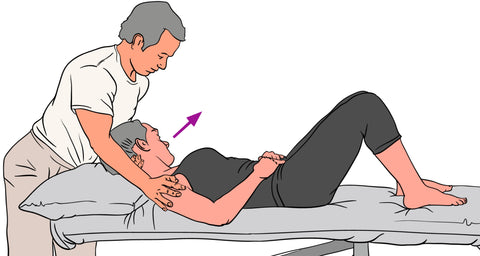Muscle Energy Techniques (MET's) emerged as a form of osteopathic manipulative diagnosis and treatment in which the client's muscles are actively used on request, from a precisely controlled position, in a specific direction, and against a distinctly executed counterforce from the practitioner.
MET's are increasingly being used by therapists in combination with trigger point therapy protocols.
MET Treatment for Levator Scapulae
For this treatment the client is supine. The therapist, while providing support, guides the client's head into a side bend, followed by flexion. If a resistance is felt prior to the chin touching the chest, this indicates relative shortness of the levator scapulae.
Some therapists find it more appropriate to treat the levator scapulae from the test position (shown at the end of this blog), rather than placing the patient in an alternative position. It will be a matter of choice, but it is generally more comfortable to treat the levator scapulae from the supine position. There are certain times when the client is unable to adopt a supine position, as this can cause discomfort, for example those who present with cervical spine pain. In this case the seated position would be more appropriate for an MET treatment.

Position for MET treatment of levator scapulae
From the position of bind, the client is asked to push their cervical spine into extension to initiate the contraction of the levator scapulae. After the appropriate time and on the relaxation, the client's cervical spine is taken into further flexion, with an added left rotational movement (as shown in the illustration below).

The cervical spine is encouraged into further flexion to lengthen the right levator scapulae. The chin is taken towards the chest, with the therapist stabilising the right scapula.
Note: The levator scapula is working in an eccentric contraction when the cervical position is held in a forward head posture; this indicates that the muscle is in a lengthened position but still in a contracted state. The client may experience pain at the insertion of the levator scapulae on the superior angle of the scapulae. If this is the case, an MET to lengthen an already lengthened structure might not be appropriate.
Common Testing Method
One common method of testing the levator scapulae is from the seated position shown in the illustration below. The therapist gently assists the motion of the head and controls the cervical spine into approximately 30 degrees of right rotation.
Once the cervical spine is in the position of rotation, the therapist then encourages cervical flexion and will try to approximate the client's chin onto their chest. The therapist’s right hand prevents the scapula from elevating. When the therapist feels a bind, the range of motion is noted. If the chin can approximate the chest with no resistance, the levator scapulae is generally classified as normal.

Комментариев нет:
Отправить комментарий